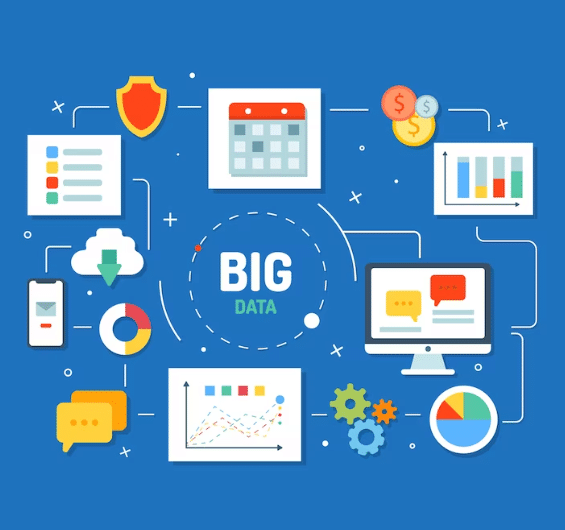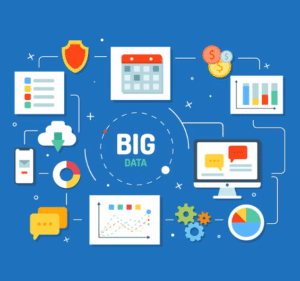In today’s data-driven world, information is power. Big data has emerged as a transformative force across industries, offering organizations unparalleled insights and opportunities for growth. From healthcare to finance, and from marketing to logistics, big data is reshaping the way we make decisions and conduct business. In this comprehensive guide, we will explore the concept of big data, its significance, the technologies that underpin it, and how organizations can maximize its potential to gain a competitive edge.
The Era of Big Data
The digital age has ushered in an era characterized by an explosion of data. Every click, swipe, purchase, and sensor reading generates a data point. As a result, we are inundated with vast amounts of information, and the challenge lies in extracting meaning and value from this deluge of data.
Understanding Big Data
1. Defining Big Data
Big data refers to the massive volume of structured and unstructured data that organizations generate daily. It encompasses data from various sources, including social media, transaction records, sensors, and more. What sets big data apart is not just its size but also its velocity, variety, and complexity.
2. The 3Vs of Big Data
Big data is often characterized by the 3Vs:
a. Volume
Volume refers to the sheer size of the data. Big data sets can range from terabytes to petabytes or even exabytes of information.
b. Velocity
Velocity signifies the speed at which data is generated, collected, and analyzed. Real-time data processing is increasingly vital in today’s fast-paced world.
c. Variety
Variety encompasses the diverse types of data, including structured data (like databases and spreadsheets), semi-structured data (like XML and JSON files), and unstructured data (like social media posts, emails, and multimedia content).
3. The 4th and 5th Vs
In addition to the traditional 3Vs, some experts include:
d. Veracity
Veracity refers to the trustworthiness and quality of data. Clean, accurate data is crucial for meaningful analysis and decision-making.
e. Value
Ultimately, the value of big data lies in its potential to drive business value. Extracting actionable insights from data can lead to improved decision-making, cost reductions, and revenue generation.
The Significance of Big Data
1. Transforming Decision-Making
Big data enables organizations to make data-driven decisions, reducing reliance on intuition and guesswork. This data-driven decision-making is especially valuable in industries like finance, where accurate predictions are critical.
2. Enhancing Customer Experiences
By analyzing customer data, organizations can personalize offerings, tailor marketing campaigns, and improve customer service, ultimately enhancing the customer experience.
3. Optimizing Operations
Big data helps organizations optimize internal processes, reduce inefficiencies, and lower operational costs. For example, logistics companies use real-time data to optimize route planning and fuel consumption.
4. Predictive Analytics
Predictive analytics uses historical and real-time data to forecast future trends and outcomes. This is invaluable in healthcare for predicting disease outbreaks or in retail for forecasting demand.
5. Innovating Products and Services
Data analysis can reveal unmet needs and opportunities for innovation. Companies like Amazon have used data to launch new product categories.
6. Improving Risk Management
Financial institutions use big data to assess and mitigate risks. By analyzing vast amounts of data in real-time, they can detect fraudulent activities and assess creditworthiness more accurately.
Technologies Underpinning Big Data
To harness the potential of big data, organizations rely on various technologies and tools:
1. Data Storage
a. Databases
Relational databases like MySQL and PostgreSQL are used for structured data, while NoSQL databases like MongoDB and Cassandra handle unstructured and semi-structured data.
b. Data Warehouses
Data warehouses like Amazon Redshift and Google BigQuery are designed for efficient querying and analysis of large datasets.
2. Data Processing
a. Hadoop
Hadoop is an open-source framework that allows distributed processing of large datasets across clusters of computers. It is instrumental in handling big data.
b. Spark
Apache Spark is a fast, in-memory data processing engine. It is known for its speed and ease of use in big data processing.
3. Data Integration
Data integration tools like Apache Nifi and Talend help organizations collect, clean, and combine data from various sources.
4. Data Visualization
Tools like Tableau and Power BI enable users to create visualizations and dashboards to explore and communicate data insights effectively.
5. Machine Learning and AI
Machine learning algorithms, supported by frameworks like TensorFlow and scikit-learn, are used for predictive analytics and automated decision-making.
6. Cloud Computing
Cloud platforms like AWS, Azure, and Google Cloud provide scalable and cost-effective infrastructure for storing and processing big data.
Maximizing the Potential of Big Data
1. Define Clear Objectives
Before diving into big data initiatives, organizations should define clear objectives. What specific business problems are you trying to solve? What outcomes are you aiming for?
2. Collect Relevant Data
Identify the types of data that are relevant to your objectives. Ensure data quality and veracity by cleansing and validating the data.
3. Choose the Right Tools and Technologies
Select tools and technologies that align with your objectives and data requirements. Consider factors like scalability, ease of use, and cost.
4. Invest in Data Analytics Skills
Organizations should invest in data analytics skills and talent. Data scientists and analysts play a crucial role in extracting insights from big data.
5. Embrace a Data-Driven Culture
Foster a culture that values data-driven decision-making. Encourage employees to use data in their daily activities and decision-making processes.
6. Secure Your Data
Data security is paramount. Implement robust security measures to protect sensitive data and ensure compliance with data protection regulations.
7. Continuously Monitor and Adapt
Big data is dynamic. Continuously monitor data sources and analysis processes to adapt to changing business needs and opportunities.
8. Ethical Considerations
Be mindful of ethical considerations when handling big data, especially when dealing with sensitive personal information. Ensure data privacy and compliance with regulations.
Challenges and Considerations
While big data offers immense potential, it comes with challenges:
1. Data Privacy and Security
Collecting and storing vast amounts of data can expose organizations to privacy and security risks, necessitating robust security measures.
2. Data Quality
Dirty or inaccurate data can lead to flawed insights and poor decision-making. Data cleansing and validation are essential.
3. Scalability
As data volume grows, organizations must ensure that their infrastructure and tools can scale effectively.
4. Talent Shortages
The demand for data scientists and analysts often outstrips supply, making it challenging for organizations to find and retain skilled talent.
5. Costs
Big data initiatives can be costly, from infrastructure and tools to personnel and training.
6. Integration Complexity
Integrating disparate data sources can be complex and time-consuming, requiring data integration expertise.
Real-World Applications of Big Data
1. Healthcare
Big data is used for patient care, drug discovery, epidemiology, and predicting disease outbreaks.
2. Finance
Financial institutions use big data for fraud detection, risk assessment, algorithmic trading, and customer insights.
3. Marketing
Marketers leverage big data for personalized marketing campaigns, customer segmentation, and market analysis.
4. Retail
Retailers use big data for demand forecasting, inventory management, and optimizing the customer shopping experience.
5. Transportation
In the transportation sector, big data is applied to route optimization, traffic management, and predictive maintenance.
Conclusion
Big data is not just a buzzword; it’s a transformative force that has the potential to revolutionize how organizations operate and make decisions. From enhancing customer experiences to optimizing operations and driving innovation, the benefits of big data are substantial. However, organizations must navigate challenges related to data privacy, quality, and talent shortages to maximize the potential of big data fully. As technology continues to evolve, so too will the opportunities and challenges presented by big data. Embracing this data-driven paradigm is no longer a choice but a necessity for organizations aiming to stay competitive in a rapidly changing world.

